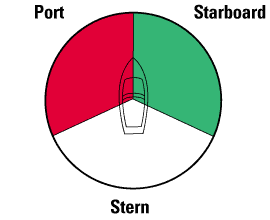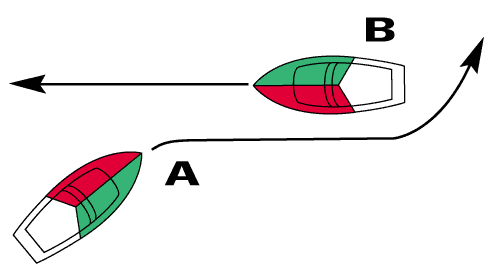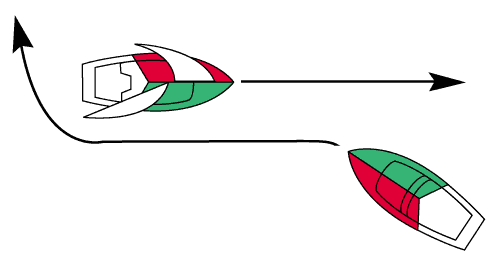Chapter 6: Nautical Rules of the
Road
 |
Port: If a
power-driven vessel approaches
within this sector, maintain
with caution, your course and
speed. |
Starboard:
If any vessel approaches within
this sector,
keep out of its way.
(Note: This rule may not
always apply if one or both
vessels are sailboats.) |
|
Stern: If
any vessel approaches this
sector, maintain with caution,
your course and speed. |
Operating Rules
Boat operation is subject to a series
of rules similar to those governing road
traffic. The Collision Regulations and
the Criminal Code of Canada are two
valuable sources of information for
anyone interested in more details on the
regulations governing the operation of a
vessel. The following are a few of the
many rules they set down.
Rules of the Road
The rules of the road in navigation
are often similar to the rules on land.
The Collision Regulations contain many
rules pertaining to navigation; however,
four rules are basic to navigation.
A boat that is overtaking another
must steer clear of the overtaken
vessel’s path.

A vessel approaching from the port
side must give way. (A) keeps
clear of and must avoid crossing ahead
of (B).

When two vessels are heading toward
each other, each must reroute and pass
to the right of the other. (A) blows one
blast and alters course to starboard,
(B) blows one blast and alters course to
starboard.

As a general rule, rowboats, sailing
vessels and canoes have the right-of-way
over power- driven boats. However, if
one vessel is unable to maneuver as it
normally would, the most maneuverable
vessel gives way.

Responsibility for avoiding
collisions is shared by everyone using
the waterway. Common sense must be used
along with alertness and caution.
The concept of taking early and
substantial action must be applied in
all cases.
Alertness
The Collision Regulations requires
that anyone operating a vessel be
constantly on the alert, both in sight
and sound.
Operating a vessel requires the
operator’s sustained attention;
operators must be constantly alert and
watchful to everything around them. Not
only must they take account of what is
happening in front, behind and on both
sides of them, like a road vehicle
driver, but they must also pay attention
to what is under them. A single glance
at the sky is enough to see the early
signs of bad weather, or perceive
impending dangers (electrical wires or
others).
The water surface can also conceal
dangers: tree trunks, water plants,
rocks near the surface, etc. For that
reason, they required deep concentration
when operating a boat. This alertness
allows the operator to adjust speed to
boating conditions, and thereby enhance
the safety of the operator and of
others.
The Effect of Waves
One of the rules governing the
operation of a vessel is that “every
vessel is responsible for the effects of
its wake.” Boat operators must
therefore ensure that the wake of their
vessel does not endanger nearby pleasure
boaters or cause property damage to
their vessels.
Boaters coming to help must not
compound the circumstances of an
accident or, for that matter, cause
another one. The effect of the boat’s
wake is extremely important when
approaching the victim. Steps must be
taken to ensure the wake is not so high
that it washes over the victim.
Lastly, pleasure craft operators must
know that they cannot interfere with
marine signals, as stipulated in section
439 of the Criminal Code of Canada, by:
- mooring the vessel to a signal,
buoy or other sea-mark used for
navigation; or
- willfully altering, removing or
concealing a signal, buoy or other
sea-mark.
Provisions of the Collision
Regulations pertaining to the conduct of
pleasure craft in sight of other
vessels.
Know that the operator of a pleasure
sailing craft, that has the wind on the
port side, shall take early and
substantial action to keep well clear of
other sailing vessels as described in
the Collision regulations, Rules 12 and
16.
Know that the operator of a pleasure
sailing craft, that has the wind on the
same side and is to windward of other
sailing vessels, shall take early and
substantial action to keep well clear of
sailing vessels which are to leeward as
described in the Collision Regulations,
Rules 12 and 16.
Know that the operator of a pleasure
sailing craft, that has the wind on the
port side and cannot determine with
certainty whether other sailing vessels
to windward have the wind on the port or
on the starboard side, shall take early
and substantial action to keep well
clear of the sailing vessels as
described in the collision Regulations,
Rules 12 and 16.
Know that the operator of a pleasure
craft shall take early and substantial
action to keep well clear of vessels
being overtaken as described in the
Collision Regulations, Rules 13 and 16.
Know that the operator of a pleasure
craft, which has other power driven
vessels on his/her own starboard side
and cross them so as to involve risk of
collision, shall take early and
substantial action to keep well clear
and shall, if the circumstances of the
case admit, avoid crossing ahead of the
other vessels as described in the
Collision Regulations, Rules 15 and 16.
Boating and Alcohol
Drinking alcohol in a boat is no less
dangerous than in a car. The effects of
the sun and wind, combined with the use
of alcohol, seriously distorts judgment
and dulls the reflexes. Unfortunately,
alcohol is a factor in a high percentage
of fatal boating accidents. In December
1985, major amendments to the Criminal
Code of Canada took force in regard to
vessels. These amendments led to more
severe police action, especially for
offences committed under the influence
of alcohol.
Dangerous Driving
Section 249(1)b of the Criminal Code
of Canada provides:
“Everyone commits an offence who
operates a vessel or any water skis,
surf-board, water sled or other towed
object on or over any of the internal
waters of Canada or the territorial sea
of Canada, in a manner that is dangerous
to the public, having regard to all the
circumstances, including the nature and
condition of those waters or sea and the
use that at the time is or might
reasonably be expected to be made of
those waters or sea;”
Everyone one who commits an offence
under this section may be sentenced to
imprisonment for a term not exceeding
five years.
If the offence caused bodily harm to
another person, the length of
imprisonment may be up to ten years.
If the offence caused the death of
another person, the person who committed
the offence is liable to imprisonment
for a term of up to fourteen years.
Section 250(1) of the Criminal Code
of Canada also provides:
Another responsible person must be on
board a vessel to keep watch on any
person being towed.
Impairment
The most radical change to the
Criminal Code of Canada, 1985, in regard
to boating concerns the operation of
boats by impaired persons.
Section 253 of the Criminal Code of
Canada provides:
“Every one commits an offence who
operates a motor vehicle or vessel or
operates or assists in the operation of
an aircraft or of railway equipment or
has the care or control of a motor
vehicle, vessel, aircraft or railway
equipment, whether it is in motion or
not,
- while the person's ability to
operate the vehicle, vessel,
aircraft or railway equipment is
impaired by alcohol or a drug; or
- having consumed alcohol in such
a quantity that the concentration in
the person's blood exceeds eighty
milligrams of alcohol in one hundred
millilitres of blood.”
The Criminal Code amendments allow
officers of the peace who have
reasonable grounds to suspect that a
boat operator has used alcohol to
request that such operator take a
breathalyser test, just as they would
for a car driver.
Now, there is no distinction between
driving a car and driving a boat if the
operator is impaired; the offence is the
same. Refusal by a car driver or boat
operator to take a breathalyser test is
also an offence.
The sentences involved in committing
the offence of driving while impaired
are the same for boats or cars. For a
first offence, the minimum sentence is
$600. For a second offence, the minimum
sentence is 14 days of imprisonment.
For each subsequent offence, the
offender may be imprisoned for at least
90 days.
These above convictions reflect
minimum sentences. Whenever bodily harm
is involved, the Court is free to impose
a sentence of imprisonment of up to 10
years. If the offence results in the
death of another person, the sentence of
imprisonment can be as long as
imprisonment for life.
In addition to the above sentences,
the Courts can prohibit the convicted
person from operating a boat for at
least three months. Anyone found
operating a boat while under such a
suspension is liable to two years of
imprisonment.
Although the Courts cannot suspend
the operating license of a person found
guilty of a boat operation offence, they
may and must prohibit such persons from
operating a boat for at least three
months.
For an offence set out in the
Criminal Code providing a minimum
sentence of 14 days of imprisonment for
a second offence, the two offences need
not have been committed in the same
circumstances. In other words, if a
person was guilty of driving a boat
while impaired and later a vehicle, or
vice versa, the second time would be
considered a second offence, and the
offender would spend at least fourteen
days in prison. Obviously, the same
reasoning applies to any subsequent
offence.
The offence of “Careless Operation of
a Vessel”, has been added to the Small
Vessel Regulations. An operator who is
doing any of the following could be
charged:
- traveling in a way that could
adversely affect the safety of
people or property considering the
weather, boat traffic, hazards or
potential hazards, or the number of
people around the boat
- operating a vessel in a careless
manner, without consideration for
other people or for the factors
listed immediately above.
Others have been added to the
Criminal Code of Canada:
- operating a vessel dangerously
- operating a vessel when impaired
- towing water skiers improperly
- failing to stop at the scene of
an accident
- operating an unseaworthy vessel
Here are a few myths and realities
about boating and alcohol (based on the
brochure “Water and Alcohol - Myths and
Realities” published by the Canadian Red
Cross Society). |